I’ve been thinking a lot about Bill Mantlo in recent days, the amazing cinematic success being enjoyed by his creation Rocket Raccoon, and the tragedy of Mantlo’s own medical condition. Mostly, though, I’ve been thinking about what a great writer Bill Mantlo was. Which made me want to go back and re-present this look at one of Mantlo’s most successful and unique projects: The Micronauts.
The best projects are always personal projects, ideas that the creators are really passionate about, and are inspired to get to work on. Unlike most licensed properties in comics, MICRONAUTS was precisely that, a labor of love from a writer excited about the notion, who championed it himself, not a crass and calculated merchandising opportunity. As the story goes, Marvel Comics writer Bill Mantlo discovered Mego’s Micronauts toys in his local Toys R Us (his eye no doubt caught by the striking photography used on the package design), and took an armload of them to his boss, Marvel’s Editor-in-Chief Jim Shooter, pitching that they talk to the folks at Mego and get a comic book going. Shooter did exactly that, and not long after, MICRONAUTS #1 hit the stands in January 1978, written by Mantlo and drawn by the amazing Michael Golden.
Mantlo and Golden took what could have been the crassest and tackiest of commercial endeavors, a comic book based on plastic toys, and instead created a captivating mix of science-fiction, fantasy, mythology and superhero action, with a unique flavor and heart all its own. The story opens on the planet of Homeworld somewhere in the Microverse, a subatomic universe all its own. Homeworld is currently under the thumb of the despot Baron Karza, who has seized rule through means both military and civilian: not only do his Dog Soldiers terrorize the planet and his allies the Acroyears patrol the skies, but the rich and powerful elite of Homeworld support him due to his control of the Body Banks, which can keep them forever young through the forced harvestation of the bodies of Homeworld’s underclass.
(And by the way, what an ingenious and insidious idea on Bill Mantlo’s part, to play off the toyline’s “interchangeable” nature in such a vicious and sinister fashion. Under Karza, the citizens themselves are interchangeable, selling or gambling away their organs in the Body Banks in the hopes of immortality, or forfeiting them altogether as a member of his Dog Soldiers. Creepy.) Although there’s still a rebellion on Homeworld led by Prince Argon and Princess Mari, the last remnants of the royal family, it is nearing its demise, especially after Argon is captured by Karza’s Dog Soldiers.
Unexpectedly, a long-forgotten figure arrives on Homeworld: its first space explorer (or “Micronaut”), Commander Arcturus Rann, who had left Homeworld a thousand years earlier in his starship, the HMS Endeavor, and had spent the previous 10 centuries exploring alien worlds while mentally linked with Biotron, his ship’s roboid, while his body lay slumbering in suspended animation. Commander Rann, with his helmet and glider pack, is the comic-book version of the “Space Glider” toy, by the way, although he’s never called that in the book itself and only occasionally referred to that way in the comic’s “roll call.”
Unfortunately for Commander Rann (who the more Silver Age-minded among you may have noticed is named for the adopted homeworld of another space explorer from another publisher), while he was trudging through space at light speed, back on Homeworld, Karza’s scientists invented the warp drive, and his armies conquered the same worlds Rann had been traveling to greet. Karza, by the way, had been Rann’s professor, and Rann’s parents, Dallan and Sepsis, had been the first of the ruling class to stand against Karza, for which they were murdered at Karza’s hands, the two of them becoming martyrs to the fledgling rebellion.
Rann finds all this out when he awakes in his prison cell after being arrested by Karza’s Dog Soldiers the second he lands. In prison, he meets two other prisoners of Karza, aliens both: Bug, an Insectivorid thief, and Acroyear, the crown prince of his race (which is why he bears the race’s name as his own, in case you were wondering).
Bug is locked up for simple thievery, while Acroyear is a political prisoner, with his traitorous brother Prince Shaitan collaborating with Karza to deceive his people into agreeing to serve Karza’s rule.
With the assistance of Princess Mari (now masquerading as the dancer Marionette) and her roboid Microtron, Bug and Acroyear manage to bust Commander Rann out of the prison and the scheduled public execution, along with some advice from the mysterious Time Traveller, a cosmic figure who claims to be linked to something called the “Enigma Force.”
Rann, Mari, Bug, Acroyear and Microtron hustle back to the Endeavor and the waiting Biotron, and the six Micronauts head back into space, to the very fringes of the Microverse — only this time, Rann plans to punch his way through to whatever’s on the other side.
A lot of backstory and setup to squeeze into only 17 pages of story, but Mantlo and Golden do an amazing job of it, introducing the reader to the mythology and history of the Microverse and its various races, bringing on stage both the series’ major villain and all its primary heroes, and still telling an exciting story that left the reader waiting for the next issue. Mantlo’s dialogue was never stronger than on Micronauts, perhaps because it was his first series with characters of his own creation, and so he was able to establish distinctive speech patters for everyone early on and really stick with them. You can pluck any word balloon away from the page and discern immediately who’s speaking, which is the way it ought to be, but is a much harder trick to pull off than you’d think.
As for Michael Golden, his work here is excellent. He incorporates many of the Mego toys in appearances both obvious and subtle (like the artillery cannons, which in an oddly literal touch still have the big soft rounded rubber tips on them), but never in such a way that it feels like cheap product placement. Golden was also clearly inspired by the subject matter, designing a wholly unique architecture and fashion sense for the people and places of Homeworld, which very much transcends the source material, mixing sci-fi high-tech with a little Art Deco and some Renaissance flair.
Golden also went the extra mile with the detail, actually inventing an alphabet for the Homeworld language and subtly sprinkling it on signs and panels throughout the backgrounds. Golden’s designs for the characters, while obviously constrained by licenses on some, were still outstanding. Biotron and Microtron were scaled down from their action-figure equivalent, and given an “Artoo and Threepio” type visual relationship, which is only to be expected coming only a year after STAR WARS. Golden also does a great job lending power and expression to Acroyear’s faceless features strictly through body language, and deftly translates the minimalist Space Glider toy into a classic-looking uniform for Commander Rann very reminiscent of the Silver Age. As for Golden’s two original creations, Bug and Marionette, they both fit in well with the overall scene of things without looking like he was blatantly trying to just make up two new toys for the line; in fact it adds a bit of texture to the team and the universe, Bug adding some much-needed comic relief, and Marionette providing some much-needed sex appeal while at the same time being one of the strongest female characters in comics at the time.
So now the Micronauts were together and on the run. Where would they end up? Come back next week to find out.

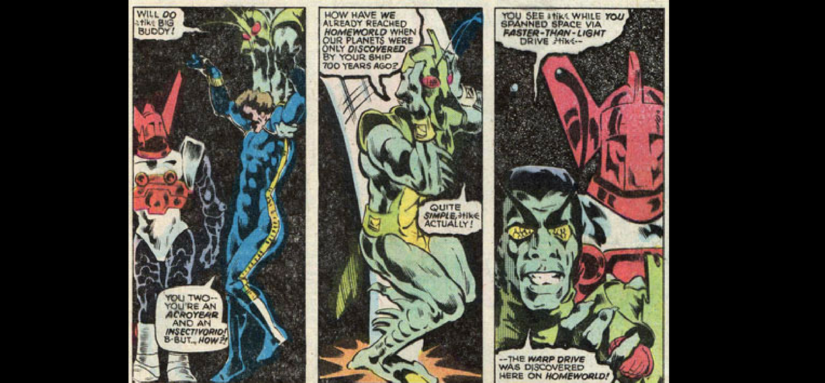
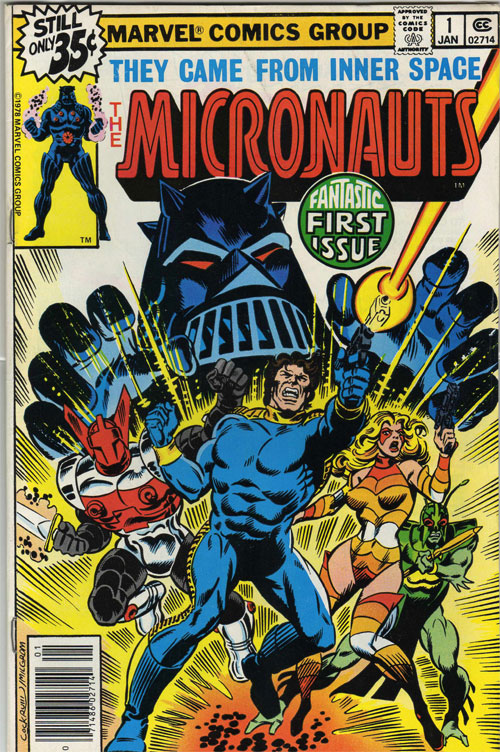

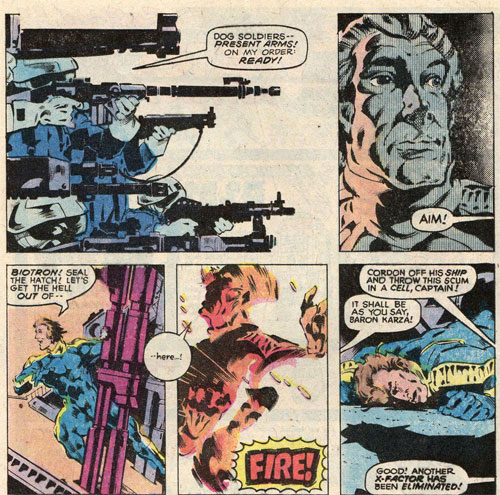
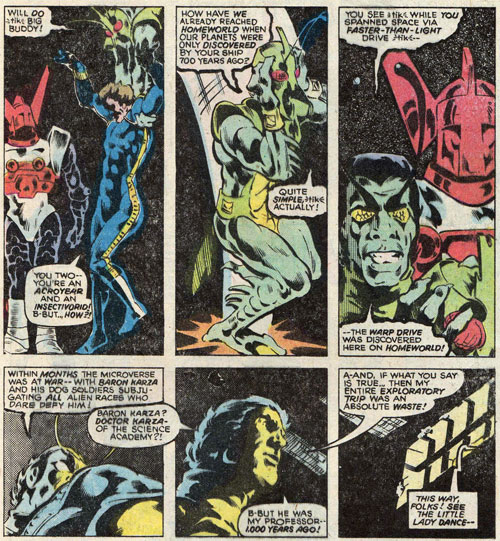
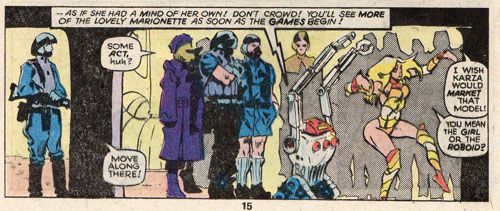
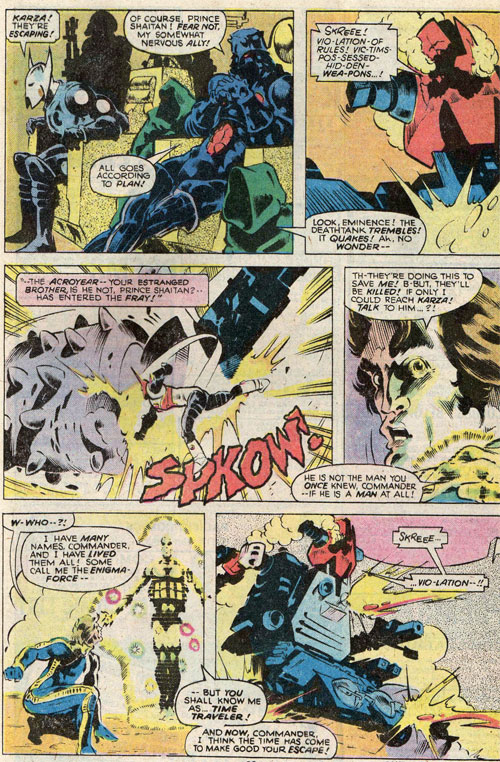
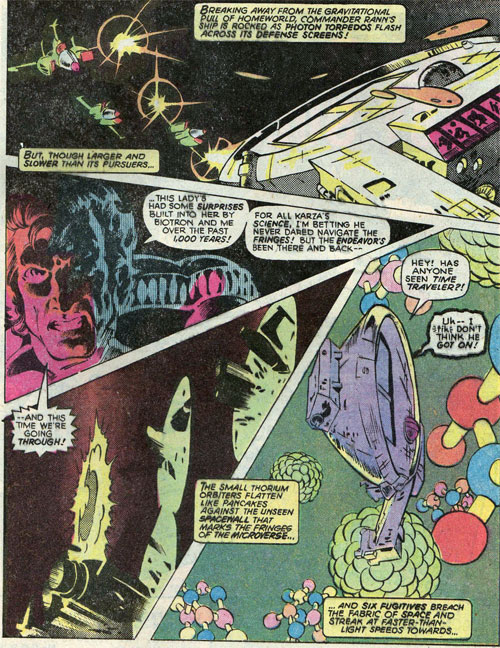
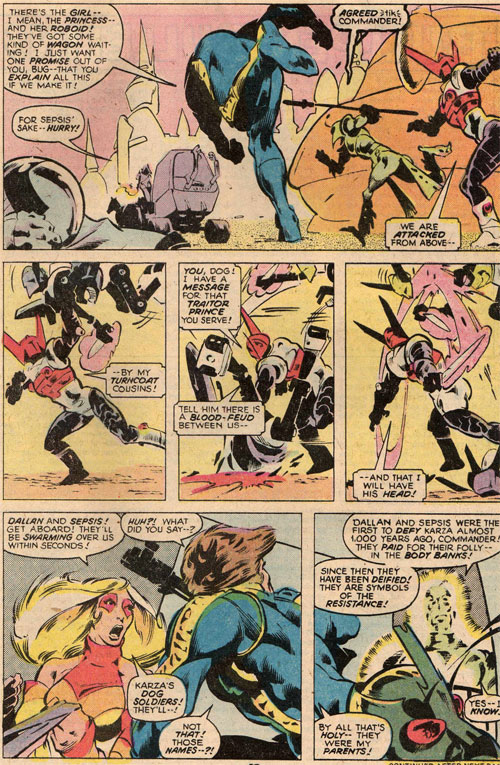

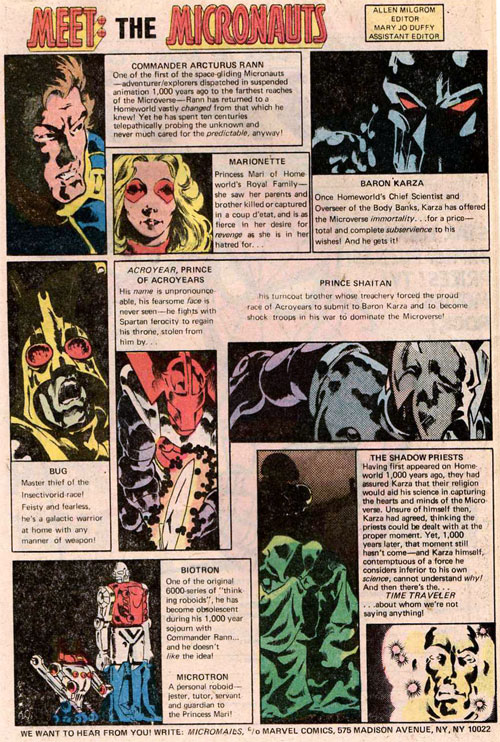
Comments are closed.